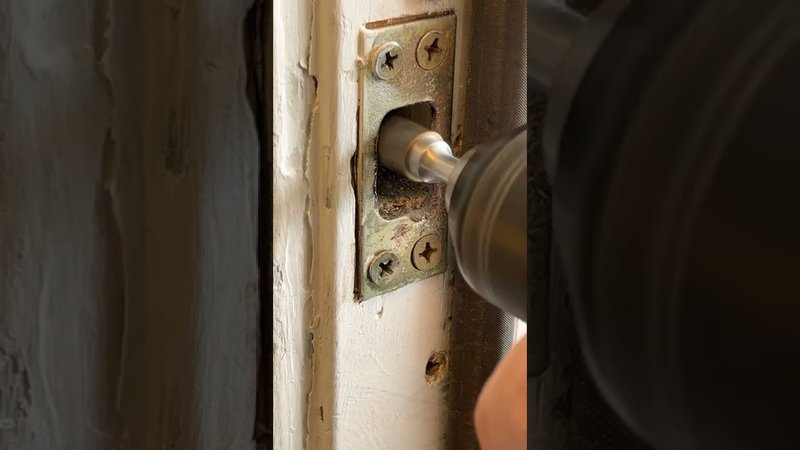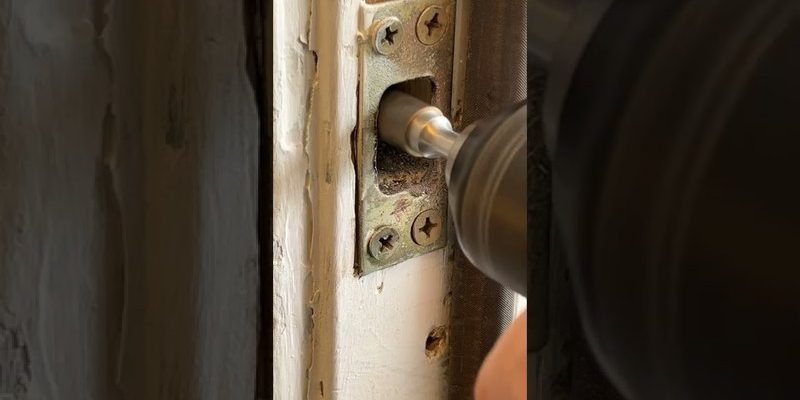
Honestly, a jammed smart lock isn’t always a sign that something’s broken forever. Sometimes, it’s the lock being overcautious, or it might be a simple battery hiccup, a wonky latch, or even a glitch in the syncing between your lock and its remote. If you’re staring at your phone screen or lock face, wondering what on earth to try next, you’re not alone—plenty of people end up in exactly this spot.
Let’s break down what’s really going on when your smart lock keeps saying “jammed,” and figure out how you can fix it step by step—without calling in a locksmith right away.
What Causes a Smart Lock to Show a “Jammed” Error?
The “jammed” error is the lock’s way of saying, “I can’t complete the locking or unlocking process safely.” It’s like a safety feature—kind of like when a garage door refuses to close if something’s blocking the sensor. Most smart locks, whether you’re using a Yale Assure, Schlage Encode, or August Lock, have built-in sensors and little motors that watch for resistance. If the internal gears hit a snag, the lock stops moving and sends the error you see in the app or on the keypad.
Here’s the thing—there could be a dozen reasons for this resistance. Sometimes, it’s something simple like a misaligned deadbolt, an old sticky door, or even just a buildup of dust in the strike plate. Don’t rule out low batteries or glitchy firmware either. The lock might be getting power but not *enough* power to finish a cycle, so it gives up halfway and reports a “jammed” status.
If you’re using a remote, app, or even a smart assistant to control your lock, poor sync or connectivity issues can also fake a jam error. The lock may have performed the action, but your app never got the memo and assumes something’s wrong. That’s why it’s important to look at both the physical and digital sides of the equation when troubleshooting.
Checking for Physical Obstructions and Door Alignment
Let me explain—most “jammed” errors actually start with the door itself, not the lock. Over time, houses settle, doors swell with humidity, and what was once a perfect fit can become a tight squeeze. If your deadbolt doesn’t smoothly glide into the strike plate, your smart lock motor feels extra resistance and calls it quits.
Here’s how you can check for physical jams:
- Manually lock and unlock the deadbolt using the old-fashioned key or thumb turn. If you feel any roughness or sticking, the problem’s not digital—it’s mechanical.
- Examine the strike plate (that metal bit on the door frame where the bolt enters). If it’s misaligned or loose, the bolt can’t slide in and out easily.
- Look for visible obstructions—dust, wood chips, or even a stray screw can cause hang-ups.
- Check for door sag by lifting the door slightly at the handle. If the lock moves smoother, the hinges may be dropping. Time to tighten screws or adjust things.
A real-life example: I once spent an afternoon fighting with a Yale Assure lock on a friend’s rental. Turned out, their door had swelled after a rainy weekend and the lock’s tiny motor just couldn’t muscle through the extra friction—manual unlocking felt sticky, and the smart lock gave up every time.
Replacing or Recharging the Smart Lock Batteries
Batteries are sneaky culprits. Most smart locks run on AA batteries, coin cells, or even rechargeable packs. When they get weak, you might think the lock still has enough juice—especially if the keypad still lights up or the app connects. But the reality is, motorized deadbolts need a lot more power to turn and lock a door than to flash a light or beep.
If you’re facing a “jammed” error:
- Replace all batteries at once with fresh, high-quality ones. Mixing old and new can cause power drop-offs.
- Check the battery compartment for corrosion or loose connections. A little white powder? That’s leaked battery acid—clean it out carefully.
- If your lock has a low-battery warning in the app, don’t ignore it. Even a few unlocks left could lead to a jam.
Pro tip: Some locks (like August or Schlage Encode) have a physical battery override or even a hidden USB terminal for emergencies. It’s worth checking the manual or app for your brand’s emergency power-up option.
Resetting or Resyncing the Smart Lock and Remote
Sometimes, your smart lock and its controlling app or remote can get out of sync. Maybe a firmware update glitched, your Wi-Fi dropped during an important moment, or the remote lost its pairing after a battery swap. This kind of digital confusion often triggers jammed errors, even if the hardware is fine.
Here’s how you can get things back on track:
- Perform a soft reset by removing and reinserting the batteries. Most locks will reboot and resync after power is restored.
- Use the app to “refresh” the connection. Look for a “sync,” “refresh,” or “resync” button in your lock’s app (Yale Access, August, Schlage Home, etc.).
- If you’re using a remote, try re-pairing it to the lock. You’ll often need to hold down a specific button until an LED blinks to enter pairing mode.
- As a last resort, factory reset your lock using the steps in your brand’s manual. Warning: this will erase all user codes and settings, so only do it if all else fails.
A quick reset can solve a surprising number of “jammed” errors. Think of it like rebooting your computer—sometimes, digital things just need a fresh start.
Updating Firmware and Troubleshooting via the App
Here’s the thing—manufacturers are always fine-tuning their smart lock firmware to fix bugs and improve reliability. If your lock’s stuck in a jam loop, an outdated code or missed update could be the root cause.
- Open your lock’s app and check for firmware updates. Most will prompt you if something’s new, but it pays to check manually.
- Follow all update instructions carefully. Don’t let your phone or the lock lose power during the process—interruptions can brick the lock or worsen bugs.
- After updating, test the lock both manually and through the app. Sometimes, updates adjust how the lock calibrates or detects jams.
Modern smart lock apps are packed with diagnostic tools. Some let you view “history” logs to see if your jammed error happens during certain times or only with certain users. Use these logs to spot patterns—like the lock always failing after your teenager gets home, which might mean rough handling or someone not closing the door fully.
When to Lubricate or Service the Lock Mechanism
Even the smartest lock is still a mechanical device at heart. Over time, dirt, weather, and regular use can gum up the workings—especially if you live somewhere dusty, humid, or salty. A dry, squeaky deadbolt or latch can trigger jam detection, since the motor senses too much resistance.
Here’s how to give your lock a little TLC:
- Use a dry lubricant (like graphite powder) inside the deadbolt and latch areas. Avoid oil-based sprays—they attract dust and can clog up the lock over time.
- Work the lock manually a few times after lubricating to spread the agent inside the mechanism.
- Wipe away any excess lubricant, especially near the battery compartment or electronics.
If you’re not comfortable taking apart the lock, many locksmiths can do a proper cleaning and lubrication job for you. In rare cases, especially with older locks or after years of use, the mechanical parts themselves might wear out—another reason your smart lock keeps jamming, no matter the troubleshooting.
Comparing Universal vs. Brand-Specific Remotes and Smart Lock Controls
If you control your smart lock with a remote or universal smart home hub (like SmartThings or Alexa), the connection between these devices matters. Universal remotes are super convenient, but sometimes they mess up the pairing or code, making your lock act up with false “jammed” errors.
- Brand-specific remotes (e.g., Yale’s proprietary remotes) are usually more reliable and sync tightly with the lock. Fewer compatibility issues, less room for error.
- Universal remotes work through a hub or cloud service and might lose connection during updates, router resets, or power outages.
- If you’re switching between different remotes or home hubs, make sure all devices are paired properly. Skip this, and you’ll face random disconnections and phantom jammed codes.
If your lock works fine with the keypad or direct app control, but jams with the remote, the problem’s probably with the pairing or sync—focus on re-pairing, resetting, or updating your hub’s firmware.
When to Call for Professional Help
Sometimes, despite all your best troubleshooting, a persistent jammed error just won’t go away. If you’ve checked the door alignment, swapped batteries, updated firmware, *and* reset everything, it’s time to look deeper.
- If the lock is still under warranty, reach out to the brand’s support. August, Yale, and Schlage all have dedicated teams who can walk you through advanced diagnostics or arrange a replacement.
- If you hear grinding noises, see flashing red lights, or the lock refuses to work even manually, the motor or internal gears could be damaged. This almost always needs professional repair or replacement.
- If you’re locked out—or the lock is crucial for safety—don’t hesitate to call a locksmith. Many are trained in smart locks now and can help without damaging your door or lock system.
Don’t feel bad about reaching out for help. Smart locks are complex, and sometimes the issue is a fault that only a pro (or a warranty replacement) can solve.
Wrapping Up: Keeping Your Smart Lock Reliable and Jam-Free
Dealing with a smart lock that keeps saying “jammed” can be a real test of patience, especially when you rely on it every day for security and convenience. The good news? Most “jammed” errors have a simple root cause—a sticky door, weak batteries, a sync issue with your remote, or a bit of wear and tear inside the lock.
By taking things step-by-step—checking for physical jams, swapping out the batteries, resyncing with your remote, and staying on top of updates—you can solve most problems yourself. A little regular maintenance keeps things running smooth, and knowing when to call in support means you’re never stuck for long.
At the end of the day, smart locks are here to make life easier, not harder. Once yours is back up and running (and free of jammed errors), you’ll wonder how you ever lived without that handy unlock beep or tap on your phone.
